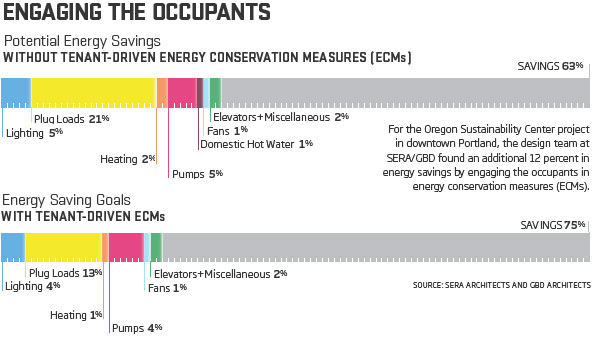Targeting Net-Zero
Most net-zero projects use PVs as the primary renewable source for electricity. SERA architect Lisa Peterson, AIA, says "when you're calculating the costs of the PVs needed to bring a building to net-zero, adding building efficiency will always be cheaper."
Plug Loads and Occupant Engagement
Once the team made the OSC building as efficient as possible, they and the owner-tenants were surprised to find that roughly half of the remaining energy demand came from occupant-generated "plug loads." These loads come from equipment, such as computers, printers, and chargers. Typically outside the scope of architects and engineers, design teams are now working with clients to engage them directly in understanding their long-term responsibility for low/zero-energy performance. According to Brockman, "When the clients realized that the users became responsible for 50 percent of the building's total projected energy load, they became much more active in participating in the net-zero design."
"Another significant part of [reducing loads] is how well a building turns off at night," says NREL's Torcellini. "You look at most commercial spaces and 70 percent of the time, they're not occupied. Often buildings don't turn off well." Smart building technology, such as motion sensors and monitoring and control software, can help reduce those down-time loads substantially.
A related variable that designers don't usually consider is occupant behavior. If users can tolerate a slightly larger range of temperatures, for example, significant savings can result. A study done by the team for the OSC found that without occupant engagement, typical energy loads could only be reduced by about 63 percent. By involving the users in energy-saving measures such as reducing hot water usage, using printers and copiers less, accepting larger temperature ranges, and reducing elevator use, they discovered another 12 percent potential reduction in loads associated with occupant behavior.
|
Â
Off-The-Grid
One way to force the net-zero issue is to keep the building off-the-grid. The LEED Platinum Audubon Center at Debs Park in Los Angeles is an example of a building that has been functioning off-the-grid since its completion in 2003. The design team didn't start with the net-zero concept, but when the architects at EHDD began calculating costs, they found a huge expense in connecting to existing power lines at the suburban site. "The electrical connection was over a quarter of a mile away," says architect Scott Shell, AIA. "Just the infrastructure cost to bring that utility in was $125,000." In this situation, a large portion of the cost of the PV array was paid for by not connecting to the grid.
"With most zero-energy buildings, if your modeling doesn't perfectly reflect reality you can always import a little more juice, but with an off-the-grid building you have to adjust your operations," Shell adds. A bank of batteries stores enough energy for five days worth of winter operation for the center. As a contingency in times of low energy, the team devised a scheme of "load shedding" in which non-essential tasks cease first, then components are switched off in order of importance. FortuÂnately, load shedding is only likely to occur during off-season when solar radiation drops.Â
The Cost
For many buildings the costs are comparable to conventional construction. "We compared several local office buildings that were 100,000 square feet or larger," RNL's Hootman says. "The NREL facility came in the mid-range of similar projects." A power purchase agreement, in which a separate developer installs and maintains PVs and then sells power to NREL, helps to offset the costs of the system.
In analyzing building optimization software, NREL researchers see that approaches to achieving net-zero can be designed into the building without substantial costs. "Many of these strategies can be done at little or no cost if people think about these things early enough in the process," Torcellini says. He points to the Zion National Park Visitor Center in Springdale, Utah, as an example of a net-zero building that uses no conventional mechanical systems. Completed in 2000, the building was designed by National Park Service architects and NREL to respond to the hot, arid climate by using evaporative cooling towers integrated into the form of the building. As a result, the facility needed no on-site fuel storage, mechanical room, or ductwork; in Torcellini's words, the building is its own mechanical system.Â
"When you undertake these buildings you have to start shifting costs. You end up spending more money on design but less on construction," he continues. Because of this realignment in the budget (and moving some exhibit space outside), the visitor center cost 30 percent less and uses 63 percent less energy than the average National Park's visitor center.Â










